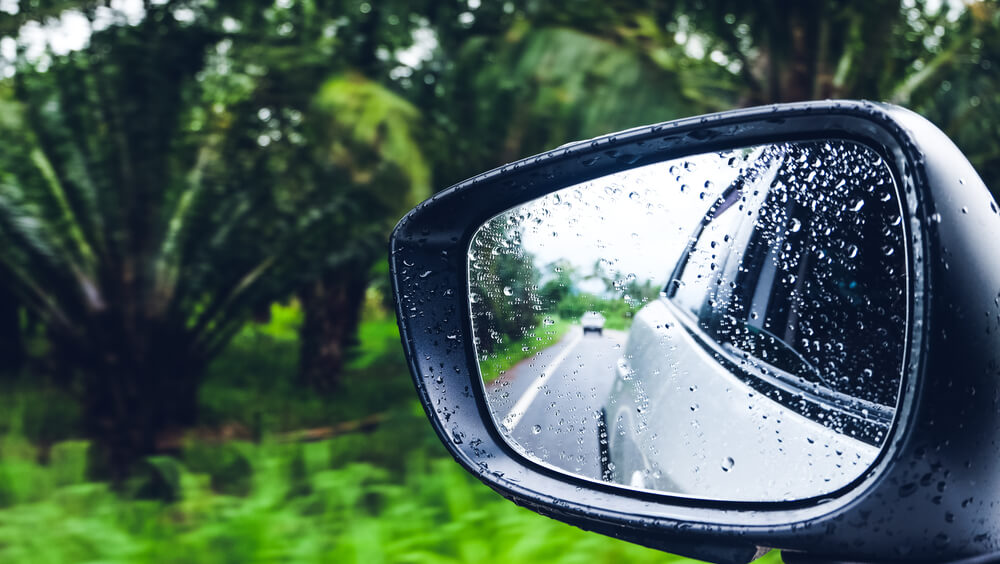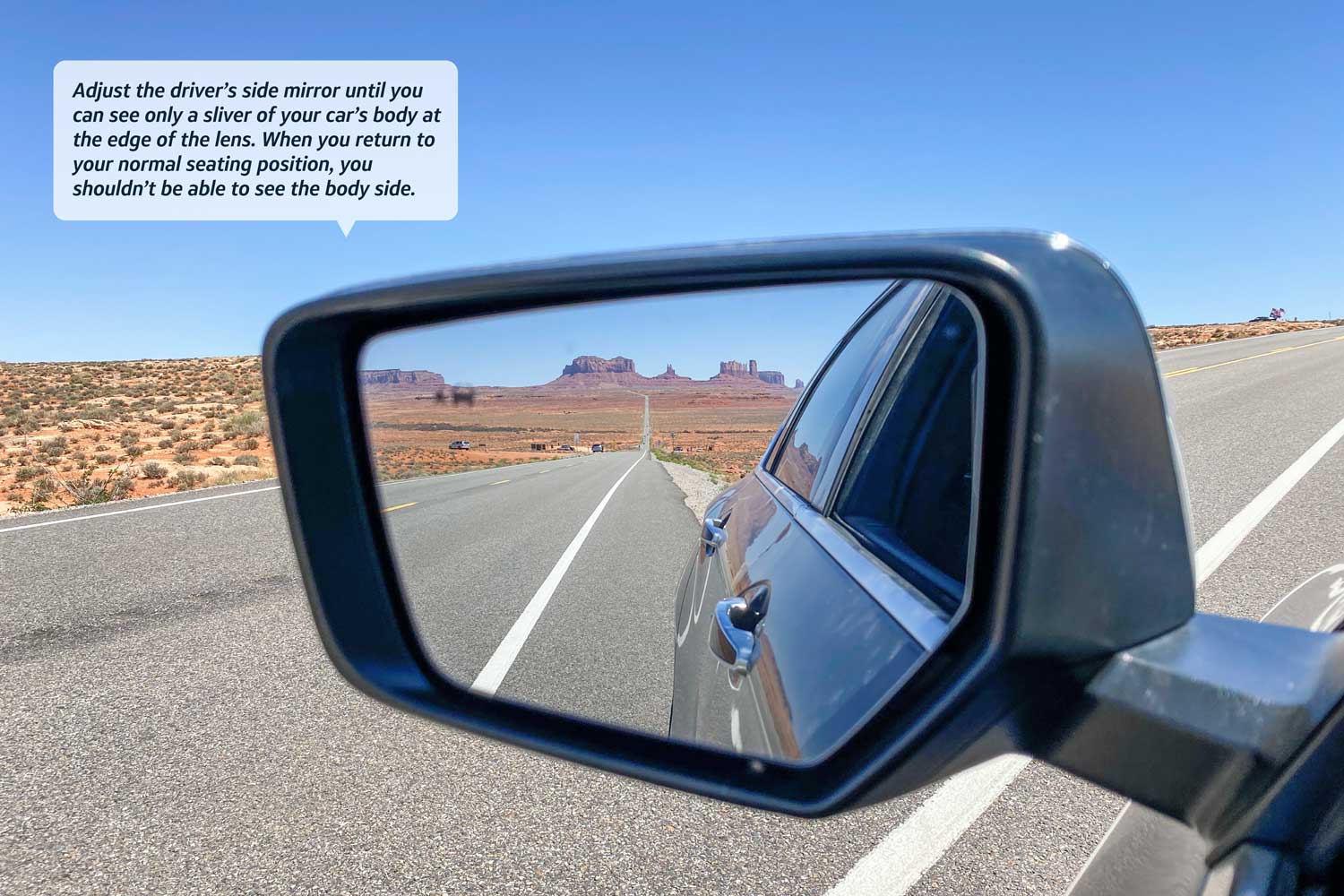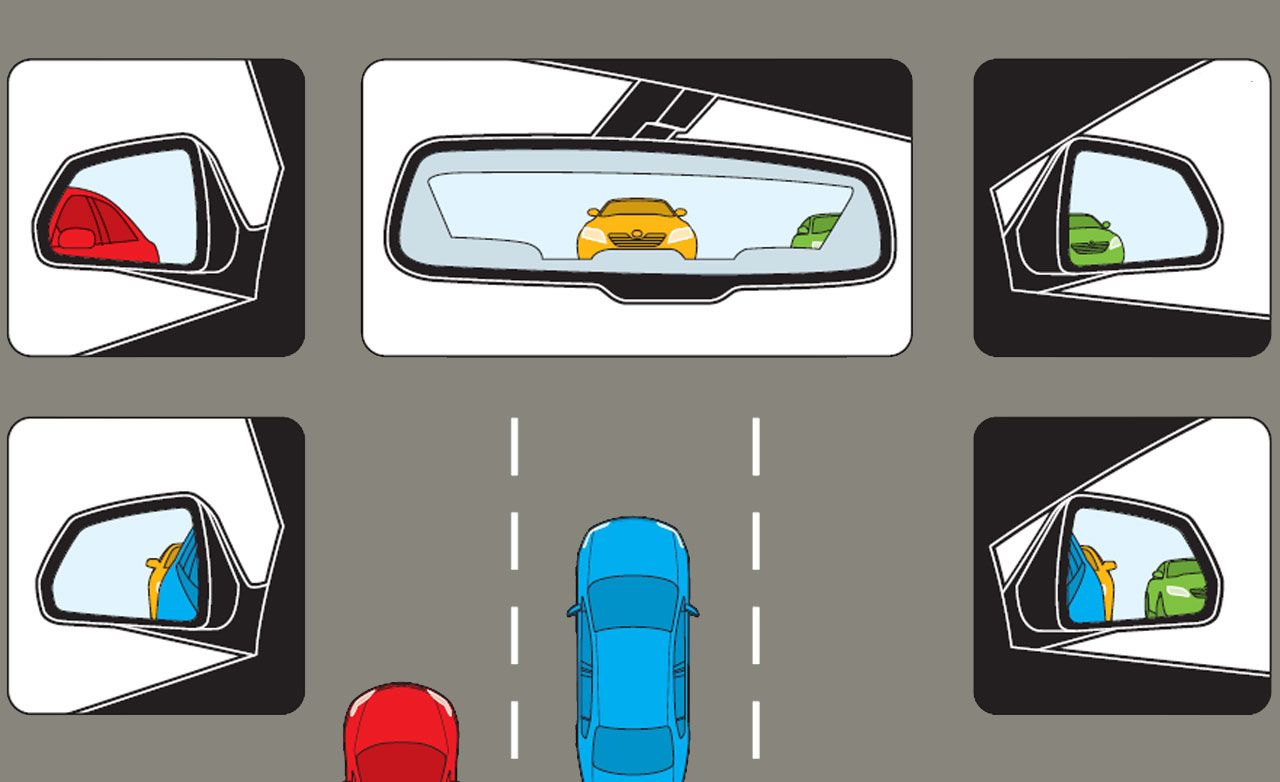Imagine you’re driving down a busy highway. Suddenly, a car appears seemingly out of nowhere, causing your heart to race.
This scenario is often the result of incorrectly positioned side mirrors. Ensuring your mirrors are adjusted properly is not just a matter of convenience; it’s a vital safety measure that can prevent accidents. So, how are side mirrors supposed to be positioned?
You’re about to discover the simple steps to optimize your mirror placement, enhancing your driving confidence and keeping those pesky blind spots at bay. Dive in to uncover the secrets of mirror positioning that could transform your driving experience and keep you safe on the road. Your journey to safer driving starts now.

Credit: driving-tests.org
Adjusting For Visibility
Adjusting your car’s side mirrors is crucial for ensuring safety on the road. Properly positioned mirrors can drastically improve your visibility, making driving a less stressful experience. Having your mirrors aligned correctly is not just about comfort, but it’s a vital safety feature that can prevent accidents. But are your side mirrors set up to give you the best view possible?
Eliminating Blind Spots
Blind spots are the enemy of safe driving. They hide vehicles that might be overtaking you or are in adjacent lanes. To reduce blind spots, start by adjusting your side mirrors outward. This means you should not see the side of your car in your mirrors. Instead, the mirror should show the lane next to you. This adjustment gives you a broader view of the road, revealing any hidden vehicles.
Try this: as you adjust the mirror, have a friend stand beside your car, moving slowly backward. Your goal is to see them in your mirror before they disappear from your peripheral vision. This simple test can ensure your mirrors are eliminating blind spots effectively.
Enhancing Peripheral Vision
Enhancing peripheral vision is about widening the scope of what you see. Your side mirrors should complement what you see in your rearview mirror, not duplicate it. If your side mirrors overlap too much with what you see behind you, you lose the advantage of extended peripheral vision.
Position the mirrors so they capture the area slightly beyond your direct rear view. This setup allows you to catch movements and vehicles entering your blind spot area faster. Remember, the more you see without turning your head, the safer your drive becomes.
Have you ever had a near-miss because of a blind spot? Adjusting your mirrors to expand your peripheral vision can make those close calls a thing of the past. It’s a simple change with significant impact.
By making these adjustments, you take control of your driving experience. Side mirrors are your best allies on the road when positioned effectively. How often do you check your mirror settings? A quick adjustment can be a lifesaver.

Credit: www.capitalone.com
Step-by-step Adjustment Guide
Adjusting your side mirrors correctly ensures a safe driving experience. Proper positioning minimizes blind spots and enhances road visibility. Follow this simple step-by-step guide to position your side mirrors effectively.
Driver’s Seat Positioning
First, adjust your seat to a comfortable driving position. Ensure your back is against the seat. Your hands should easily reach the steering wheel. Feet should rest comfortably on the pedals. This setup is crucial before mirror adjustments.
Mirror Angle Alignment
Start with the driver’s side mirror. Lean your head against the window. Adjust the mirror until you see a small part of your car. This helps reduce blind spots. Next, move to the passenger side mirror. Lean to the middle of the car. Adjust until only a sliver of the car is visible. This ensures a wider view of the road.
Final Visibility Check
Sit back in your normal driving position. Check if the mirrors cover all necessary angles. You should see lanes next to you. Ensure there’s minimal overlap with the rearview mirror. Conduct a quick glance test. Change lanes safely and observe the mirror coverage. Make minor adjustments if needed for perfect visibility.
Considerations For Different Vehicles
Proper side mirror positioning varies with vehicle type. Each vehicle’s design affects mirror visibility. Considering these differences enhances safety.
Sedans And Hatchbacks
Sedans and hatchbacks have lower profiles. Adjust mirrors outward to reduce blind spots. Ensure you see a small part of the car’s side. This helps in gauging distance. Proper positioning aids in lane changes and parking. Remember, seeing the road more than the car is key.
Suvs And Trucks
SUVs and trucks are larger. Their height can obscure smaller vehicles. Adjust mirrors to cover wider areas. Include the rear fenders in view. This helps in spotting nearby vehicles. Ensure mirrors are angled to view lanes clearly. This aids in safer merging and turning.
Motorcycles And Scooters
Motorcycles and scooters require different positioning. Mirrors should capture the road behind. Position them to reduce glare and reflections. Ensure they provide a full view of approaching vehicles. Adjust to see past your shoulders. Clear visibility is vital for rider safety.

Credit: www.caranddriver.com
Weather And Lighting Adjustments
Proper side mirror positioning ensures safety in different weather and lighting conditions. Mirrors should be angled to minimize blind spots and maximize visibility. Adjust them while seated, ensuring the horizon is visible and part of your car is seen.
Adjusting your side mirrors according to weather and lighting conditions can make a significant difference in your driving experience. It’s not just about seeing what’s around you—it’s about seeing clearly and safely. How often have you driven through a storm or at night, squinting to see what’s behind you? Proper mirror positioning can help you drive with confidence, no matter the conditions.Rain And Fog Conditions
During rain or fog, visibility can drop drastically. Adjust your side mirrors slightly downward to minimize the glare from headlights behind you. This adjustment can help reduce water spots and fog accumulation that distort your view. Ensuring your mirrors are clean and using anti-fog solutions can further enhance visibility. Have you ever thought about how a small change like this can make you feel more in control during inclement weather?Night Driving Tips
Night driving presents its own set of challenges. The glaring headlights from other vehicles can be distracting and dangerous. Tilt your side mirrors slightly outward so that the headlights are less intrusive. This helps in reducing glare and ensuring that you are not blinded by the lights from vehicles behind you. How do you feel about driving at night? Do your mirror adjustments reflect your comfort level in different lighting conditions? Experiment with these adjustments to find what makes you feel safest. The aim is to see clearly without straining your eyes. Next time you drive at night, try these tips and notice the difference in your visibility and confidence.Safety Benefits Of Proper Positioning
Side mirrors should be positioned to minimize blind spots and enhance visibility. Adjust them so the edge of your vehicle is barely visible. This setup ensures a safer driving experience by providing a wider view of surrounding traffic.
The proper positioning of side mirrors is not just a matter of convenience; it’s a critical aspect of driving safely. Ensuring your side mirrors are correctly adjusted can save lives and prevent accidents. It might seem like a small detail, but getting it right can make a significant difference in your daily driving experience.Accident Prevention
Properly positioned side mirrors play a key role in accident prevention. By reducing blind spots, you can see more of what’s happening around you. Imagine the peace of mind knowing you’re less likely to miss a fast-approaching vehicle or a cyclist. This visibility can prevent minor scrapes or even major collisions. Think about the last time you were in a near-miss situation. Was it because you couldn’t see the car in the next lane? Adjusting your mirrors to minimize blind spots can ensure these close calls are a thing of the past. Wouldn’t it be great to drive with more confidence, knowing your mirrors are giving you a full view?Improved Reaction Times
With your side mirrors accurately positioned, your reaction times improve significantly. The quicker you spot a potential hazard, the faster you can respond. This isn’t just about avoiding accidents; it’s about enhancing your overall driving performance. Consider this: if your mirrors give you a complete view, you’re not wasting precious seconds adjusting your position or leaning forward. Those seconds can be crucial when you’re navigating busy highways or city streets. Have you ever noticed how a small change in your mirror setup can make your driving feel smoother and more controlled? Taking the time to adjust your mirrors correctly is a small investment with big rewards. You’ll find that your driving experience is not only safer but also more enjoyable. Why not take a moment today to check your side mirrors? You might be surprised at the difference it makes.Technological Aids And Innovations
Technological aids and innovations have transformed how we view and utilize side mirrors in our vehicles. Gone are the days when you had to rely solely on manual adjustments to ensure a clear view of your surroundings. Today, a variety of advanced features are available to enhance safety and comfort while driving.
Blind Spot Monitors
Blind spot monitors are a game-changer for drivers. These sensors alert you when another vehicle enters your blind spot. This technology can be a lifesaver, especially in busy traffic where quick lane changes are often necessary.
Imagine driving on a highway with cars whizzing past. You’ve checked your mirrors but still hesitate to change lanes. A gentle beep or light on your side mirror provides the assurance you need to proceed safely. If your car isn’t equipped with this feature, consider it during your next vehicle upgrade.
Advanced Mirror Technologies
Advanced mirror technologies are continually evolving. Electric and heated mirrors are now common, preventing fog and improving visibility in adverse weather conditions. This small yet significant innovation means you spend less time adjusting mirrors and more time focusing on the road.
Some vehicles now feature auto-dimming mirrors to reduce glare from headlights behind you. This can be especially helpful during night driving, reducing eye strain and improving concentration. Have you ever found yourself dazzled by bright lights in your rearview mirror? Auto-dimming mirrors offer a solution to this common issue, making night drives less stressful.
With these technological aids, driving becomes safer and more enjoyable. As these innovations become more accessible, consider how they might fit into your driving habits. How are you ensuring your car’s mirrors are optimized for safety?
Expert Opinions And Recommendations
Properly positioned side mirrors are crucial for safe driving. Expert opinions can guide you in adjusting your mirrors effectively, ensuring you minimize blind spots and enhance your field of vision. Let’s delve into insights from professionals who understand the nuances of mirror positioning.
Driving Instructor Insights
Driving instructors often emphasize the importance of adjusting your mirrors before you even start driving. A seasoned instructor once shared how he teaches his students to position side mirrors. He recommends sitting comfortably in the driver’s seat and leaning your head towards the window. Adjust the mirror so you can barely see the side of your car. This approach reduces blind spots significantly. Have you ever tried this technique?
Another instructor advises checking your mirror position regularly. He suggests using landmarks, like a specific building or tree, to ensure consistency. This can be particularly useful if multiple people drive your car. How often do you check if your mirrors are aligned correctly?
Automotive Expert Advice
Automotive experts offer a slightly different perspective. They often stress the importance of technology in mirror positioning. Many modern cars come with blind spot monitoring systems that complement mirror adjustments. An expert once noted how these systems can be lifesaving, especially when driving on highways.
Some experts advocate for experimenting with mirror angles. They suggest adjusting mirrors slightly outward compared to traditional positions. This may seem counterintuitive, but it can offer a broader view of the road. Have you considered trying unconventional angles to test their effectiveness?
These insights can transform your driving experience. Whether you’re a new driver or a seasoned one, refining your mirror positioning can make a significant difference in safety. Do you think your current mirror setup optimizes your driving safety?
Conclusion
Positioning side mirrors correctly boosts safety and confidence on the road. Proper alignment helps spot vehicles in blind spots, reducing accidents. Make small adjustments until you see the road clearly. Ensure a clear view of the lane beside you. Regularly check and readjust mirrors for optimal visibility.
Stay aware of changing conditions and adjust as needed. Practice makes perfect, so keep at it. Safe driving depends on clear mirrors. Keep them clean and properly positioned. Your safety and others depend on it. Happy and safe driving!
